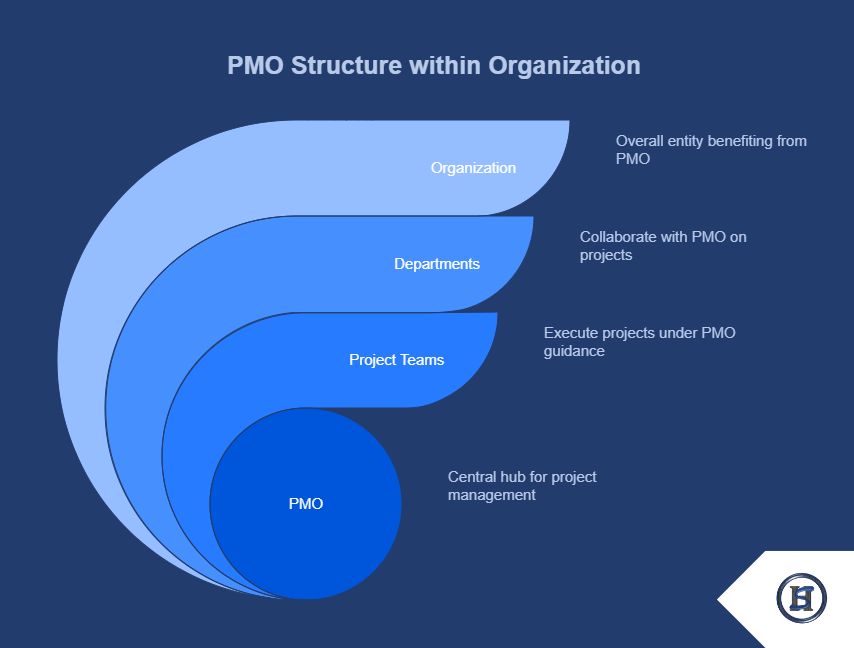Ever wondered why some organizations consistently deliver successful projects while others struggle? The answer often lies in a well-structured Project Management Office (PMO). At Haile Solutions, we’ve seen firsthand how a properly implemented PMO can transform an organization’s project delivery capabilities overnight.
What Exactly Is a PMO?
A Project Management Office (PMO) is a specialized department within an organization that establishes and maintains project management standards. Think of it as the backbone that supports all your project management activities.
Unlike individual project managers who focus on specific projects, a PMO takes a broader view, creating consistent approaches that benefit the entire organization.

Types of PMOs You Should Know About
Not all PMOs are created equal. Depending on your organization’s needs, you might implement:
- Project Management Office – Focuses on individual projects and ensuring they follow established standards
- Program Management Office – Coordinates multiple related projects that work together toward a common goal
- Portfolio Management Office – Takes a high-level view of all projects to ensure alignment with business strategy
Each type serves a specific purpose, and choosing the right one depends on your organization’s size, complexity, and project management maturity.
That said, make sure you pick the right one. We once worked with an organization that created a Program Management Office intending to coordinate multiple related projects, but then decided to focus on individual projects. The problem was that the Program Management Office was expensive and inappropriate, so the business canceled the program altogether, when it may have made more sense to review the PMO.
Key Functions of an Effective PMO
A well-run PMO handles several critical functions that keep your projects on track:
| Key Function | Description |
| Strategic Planning | Aligns projects with business goals to ensure every project contributes to achieving strategic objectives. |
| Project Governance | Establishes clear decision-making frameworks and processes to manage issues, risks, and changes that affect project outcomes. |
| Methodology and Standards | Defines and enforces consistent project management approaches tailored to the organization’s needs and industry standards. |
| Best Practices Implementation | Identifies and implements proven methods to improve project success, avoiding the need to start from scratch each time. |
| Resource Management | Optimizes allocation of team members to ensure the right people are working on the right projects at the right time. |
| Tools and Templates | Develops standardized tools and templates to streamline and unify project management processes across the organization. |
The PMO Dream Team: Key Roles
A successful PMO relies on skilled professionals in various roles:
PMO Manager
The leader who oversees the entire PMO operation, ensuring alignment with organizational goals. In smaller organizations, this might be the Operations Manager or Director.
PMO Analyst
Data-driven professionals who track project metrics and provide insights for decision-making.
Process Specialist
Experts who define and refine the methodologies used across projects.
PMO Coordinator
The operational backbone that keeps PMO activities running smoothly day-to-day.
Have you considered which of these roles would be most beneficial to your organization right now?
Why Your Organization Needs a PMO
Implementing a PMO brings significant benefits that can transform how you deliver projects:
- Consistent approach to managing projects
- Improved resource utilization across the organization
- Better alignment between projects and strategic goals
- Higher project success rates
- Clearer visibility into project status and health
- More effective knowledge sharing between project teams
- Streamlined decision-making processes
We’ve seen organizations reduce project failures by up to 30% after implementing a properly structured PMO. That’s consistent with studies that show similar returns.*
Common PMO Misconceptions
Many organizations fall into the “Plug and Play” trap – thinking that simply establishing a PMO will instantly solve all project management problems.
The truth? A successful PMO requires careful planning, alignment with your organizational needs, and ongoing refinement.
A PMO isn’t just an administrative function. When done right, it’s a strategic partner that helps drive organizational success through better project execution.
How to Build an Effective PMO
Ready to establish or improve your PMO? Here’s our proven approach:
- Assess your current project management maturity. Where are you now? This baseline helps determine your next steps.
- Define clear objectives for your PMO. What specific problems should your PMO solve? What would success look like?
- Secure executive sponsorship. PMOs need support from leadership to be effective.
- Start small and expand gradually. Begin with a focused scope and build on your successes.
- Measure and communicate value. Track PMO performance and share wins with stakeholders.
- Continuously improve. Regularly reassess and refine your PMO functions based on results.
The key is tailoring your PMO to your organization’s needs rather than following a generic template.
Implementing a PMO

PMO Implementation Challenges
Building an effective PMO isn’t without challenges. Common obstacles include:
- Resistance to standardized processes. It is a change after all.
- Difficulty demonstrating immediate value
- Balancing control with flexibility
- Finding skilled PMO staff
- Securing adequate resources
At Haile Solutions, we help organizations navigate these challenges by implementing practical, tailored approaches that gain buy-in from all stakeholders.
Technology's Role in Modern PMOs
Today’s PMOs leverage technology to improve efficiency and effectiveness. PMO software helps:
- Centralize project information
- Automate routine reporting
- Improve resource management
- Enable real-time project monitoring
- Facilitate better decision-making
The right technology platform can significantly enhance your PMO’s capabilities without adding an administrative burden.
Also, organizations with a PMO can leverage AI and AI agents faster as their processes will already be documented and standardized.
Getting Started with Your PMO Journey
Ready to elevate your project management capabilities? Start by assessing your current situation:
- How consistent are your current project management approaches?
- What percentage of your projects meet their objectives?
- How well do your projects align with strategic goals?
- What are the most common causes of project issues?
Your answers will help determine the type of PMO that would benefit your organization most.
Final thoughts
Remember, a PMO isn’t just about process—it’s about enabling your organization to deliver projects that drive business value consistently. Your PMO can become your secret weapon for project success with the right approach.
Ready to transform your project management capabilities? Contact Haile Solutions today to discuss how we can help you establish or optimize your PMO.
Frequently Asked Questions About PMOs
While a project manager focuses on delivering a specific project, a PMO establishes the standards, processes, and best practices that all project managers follow. The PMO takes a broader, organization-wide view while project managers implement these standards at the individual project level.
Most organizations begin seeing initial benefits within 3-6 months of proper PMO implementation. However, the full value of a PMO typically becomes apparent after 12-18 months as processes mature and become embedded in the organization’s culture.
Yes, even small organizations can benefit from PMO concepts. The scale and formality might differ, but the core principles of standardization, governance, and strategic alignment apply regardless of size. A part-time PMO role or simplified structure often works well for smaller organizations.
We focus on practical, value-driven implementation tailored to your specific needs. Unlike cookie-cutter approaches, we assess your organization’s project management maturity and design a PMO that addresses your unique challenges while building on your existing strengths.
Look for a combination of technical project management knowledge, strong analytical skills, excellent communication abilities, and change management experience. PMO professionals should understand both the theory and practical application of project management. Certifications like PMP, PMI-ACP, or PRINCE2 are valuable indicators of knowledge.
Effective metrics include project success rates, resource utilization improvements, reduction in project delays or budget overruns, and stakeholder satisfaction. We recommend establishing baseline measurements before PMO implementation to accurately track improvements.
* “State of the PMO 2010” research report by PM Solutions found that organizations with a PMO reported a 31% decrease in failed projects. Additionally, 30% of these organizations delivered projects under budget, and 19% completed projects ahead of schedule. pmsolutions.com
Recent article from BJSS highlighted that organizations with a PMO experience a 38% higher project success rate compared to those without one. BJSS






